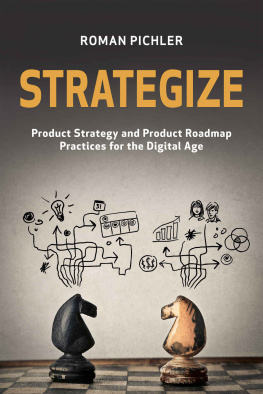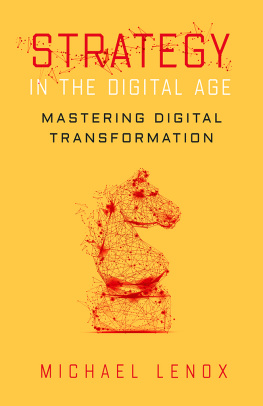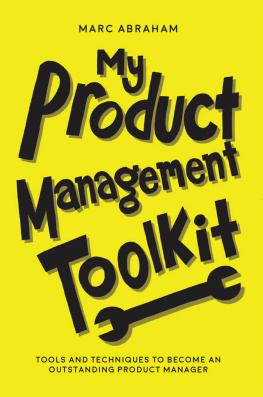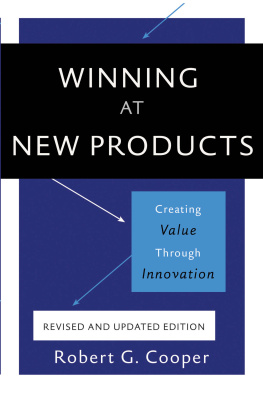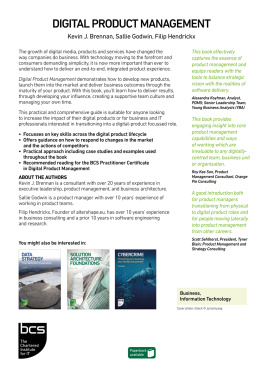STRATEGIZE
Product Strategy and Product Roadmap Practices for the Digital Age
ROMAN PICHLER
Strategize: Product Strategy and Product Roadmap Practices for the Digital Age
Roman Pichler
Copyright 2016 Roman Pichler. All rights reserved.
Published by Pichler Consulting.
Editors: Rebecca Traeger; Victoria, Bill, and Carma from CreateSpace
Design: Ole H. Strksen, Roman Pichler, and Melissa Pichler
Cover photo by Ollyy/Shutterstock
Many of the designations used by manufacturers and sellers to distinguish their products are claimed as trademarks. Where those designations appear in this book and the publisher was aware of a trademark claim, the designations have been printed with initial capital letters or in all capitals.
The author and publisher have taken care in the preparation of this book but make no expressed or implied warranty of any kind and assume no responsibility for errors or omissions. No liability is assumed for incidental or consequential damages in connection with or arising out of the use of the information or programs contained herein.
This publication is protected by copyright, and permission must be obtained from the publisher prior to any prohibited reproduction, storage in a retrieval system, or transmission in any form or by any means, electronic, mechanical, photocopying, recording, or likewise. For information regarding permissions, please write to .
ISBN Print: 978-0-9934992-1-0
ISBN ePUB: 978-0-9934992-2-7
ISBN MOBI: 978-0-9934992-0-3
Digital book(s) (epub and mobi) produced by Booknook.biz.
To my children, Leo, Yasmin, and Kai
TABLE OF CONTENTS
ACKNOWLEDGMENTS
This book would not have been possible without the help and support of many people. I would like to thank the attendees of my product strategy and roadmap workshops, as well as my blog readers, for their feedback, comments, and questions. I would also like to thank the following individuals for reviewing this book: Jock Busuttil, Mike Cohn, Kerry Golding, Steve Johnson, Ben Maynard, Rich Mirnov, Stefan Roock, Jim Siddle, and Caroline Woodhams. Special thanks to Marc Abraham for reviewing and re-reviewing the manuscript as I changed and rewrote sections. Thank you, Geoff Watts, for helping me come to grips with self-publication; and thank you, Ole Strksen, for designing the book cover and turning my sketchy images into proper graphics. I am particularly grateful to my wife, Melissa Pichler, for all her help and supportfrom reviewing the manuscript and helping me with the graphics to listening to my ideas.
PREFACE
A journey of a thousand miles begins with a single step.
Lao Tzu
Developing a successful product is not down to luck, a stroke of genius, or just trying hard enough. While these factors are undoubtedly helpful, product success starts with making the right strategic decisions. The challenge for product managers, product owners, and other product people is that we are often so preoccupied with the tacticsbe it dealing with an urgent sales request or writing new user stories to keep the development team busythat we sometimes no longer see the wood for the trees. In the worst case, we take our product down the wrong path and end up in the wrong forest; weve perfectly executed the wrong strategy and are left with a product that underperforms or even bombs. This book will help you play a proactive game, make the right strategic decisions, and use them to guide the tactical work. It explains how to create a winning product strategy and an actionable product roadmap using a wide range of proven techniques and tools.
The Big Picture: Vision, Strategy, Roadmap, and Backlog
When you look up the meaning of the term strategy, you will probably find it defined as a plan of action to achieve a long-term goal. While this definition makes sense, developing a successful strategy for a product involves two steps: finding the right overall strategy and deciding how best to implement it. To help you focus on each step and deal with its specific challenges, I discuss them separately in this book and distinguish between a product strategy and a product roadmap. The product strategy describes how the long-term goal is attained; it includes the products value proposition, market, key features, and business goals. The product roadmap shows how the product strategy is put into action by stating specific releases with dates, goals, and features. Figure 1 illustrates how the product strategy and roadmap relate, along with their connection to the vision and the product backlog.

FIGURE 1 : Product Strategy and Roadmap in Context
In Figure 1, the vision describes the ultimate reason for creating the product, the product strategy states how the vision will be realized, and the product roadmap states how the strategy will be implemented. The product backlog contains the details necessary to develop the product as outlined in the roadmap, such as epics, user stories, and other requirements. Note that the relationships between the elements in Figure 1 work in both directions: the product backlog can cause changes to the roadmap, for instance, which in turn may affect the strategy. For example, if the feedback from the customers and users indicates that the product does not adequately address their needs, or if the development progress is slow, then this may lead to product roadmap changes. Similarly, larger roadmap changes can cause product strategy adjustments. And if you cannot find a valid product strategya strategy that helps you realize the visionthen you may have to change the vision or look for a new one.
A Brief Guide to This Book
This book contains two parts. Part 1 covers product strategy practices, including determining a compelling value proposition, addressing the right segment, and selecting the right key performance indicators (KPIs). Part 2 discusses product roadmapping practices such as choosing the right roadmap format, using the right planning horizon, and reviewing the roadmap. Each practice is described in a section, and related sections are grouped into chapters. I have done my best to write the sections so that they can be read independently rather than requiring you to read the book from the beginning to the end. I have also tried to keep the sections as concise as possible, so you can read and digest them easily.
Most of the examples in this book are taken from the consumer space. The reason for this is simple: I have tried to use products that I hope you, the reader, have heard of. But the majority of practices also apply to business-to-business products. While virtually all examples are either digital products or products where software plays a key part, you can apply many of the practices to other products (although you may have to adjust them and ignore the software-specific advice).
I have written this book specifically for product executives, product managers, product owners, entrepreneurs, marketers, and others who create and manage products. You will notice, however, that I use the term product manager in the diagrams. My intention is not to exclude anyone who isnt called a product manager. Instead, I employ the term in a generic sense to refer to the person in charge of the product, no matter what the individuals actual job title is. While I am aware that product managers arent always in charge of the product strategy, I believe that anyone who looks after a product and is accountable for its success should drive the creation of both the strategy and the roadmap.
Next page
